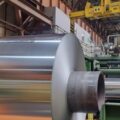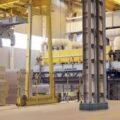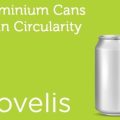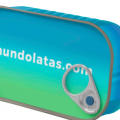Most people are unaware that compressed air is crucial to the manufacture of aluminum cans. Compressed air is used in almost every step of the manufacturing process.
Firstly note that aluminum cans are incredibly light, so it may be hard to believe that they are made from a huge roll of flat aluminum sheets, which can weigh up to nine tons and from which up to 750,000 beverage cans can be produced.
Step 1
This sheet is fed to a punching machine that punches round pieces to form the cans. The punching machine performs two operations: punching a disc and turning it into a kind of cup. The remaining metal is sent back to a facility where it is recycled into new, flat rolls.
Compressed air with or without oil is used to control the clutch/brake and eject the cup. Typical demand is 100-500 scfm at 95-100 psi, but depends on cup size and manufacturer’s requirements.
Steps 2 and 3
The cup then enters a machine called Draw Iron & Trimmer, which removes the aluminum and forms the body of the can. The Draw Iron & Trimmer uses compressed air with or without oil to eject the can and control the clutch and brakes. The trimmer uses compressed air to control the driven cylinders. The trimmer also uses vacuum to hold the can in the device to trim the walls.
Step 4
The aluminum cans move along the conveyor belt, face down, toward the washer. The washer performs a six-stage cleaning process. Compressed air with or without oil is used in the washer to control the valve actuators. Typical process demand is 45-50 scfm at 100 psi.
Step 5
Finally, the outside of the cans are printed, with some manufacturers printing up to 1,800 cans per minute.
Oil-free compressed air is used to control the clutch/brake and pneumatic cylinders.
Step 6
The inside of the cans are coated to serve as a barrier between the liquid and the metal. Compressed air with or without oil is used to control pneumatic cylinders. Typical usage is 50 scfm at 95-100 psi. Vacuum is used to hold the cans in the device for spraying the inner coating, with a typical demand of 145 scfm.
Step 7
Subsequently, a die-cutting machine performs an 11-step process to form the neck of the can. Oil-free compressed air is used to hold the can during the die-cutting process and to control the clutch/brake and pneumatic cylinders. The demand can be 500-2500 scfm depending on the number of joined banks.
Vacuum is used to hold the can in the die for the flange forming process. Vacuum demand is around 5-10 scfm. From there, the aluminum cans go through a visual inspection system to look inside each can to ensure that standards are met. If standards are not met, substandard cans are sent for recycling. If they meet the standards, they are packaged and placed on pallets and sent to the bottling companies to be filled with the beverage and the cap installed.
However, no two systems are alike in the beverage can industry, due to the number of lines, the size of the cans and the speed of manufacturing. Therefore, it is always best to consult a compressed air expert to ensure that the can forming operation will produce aluminum cans, and that it is not a problem to do so.














